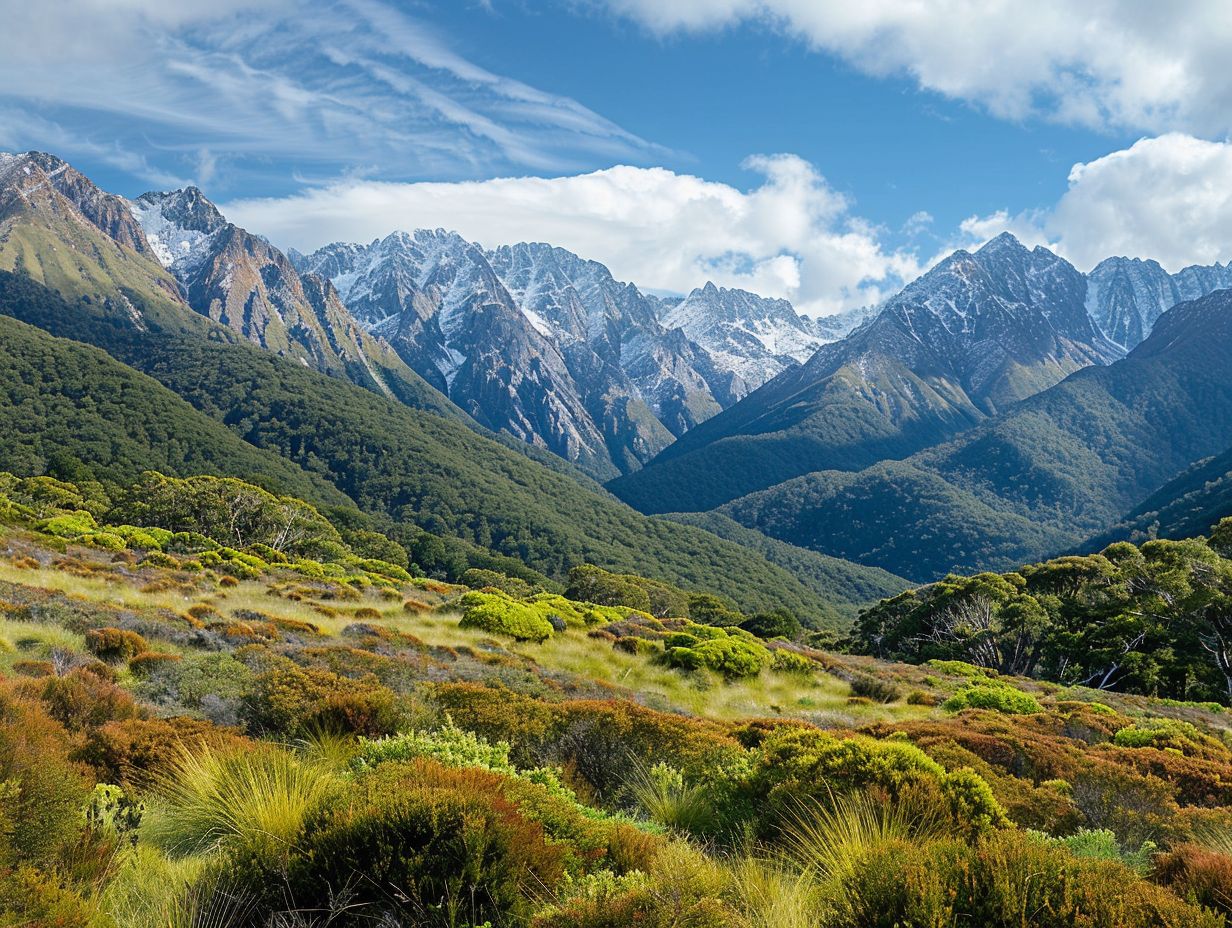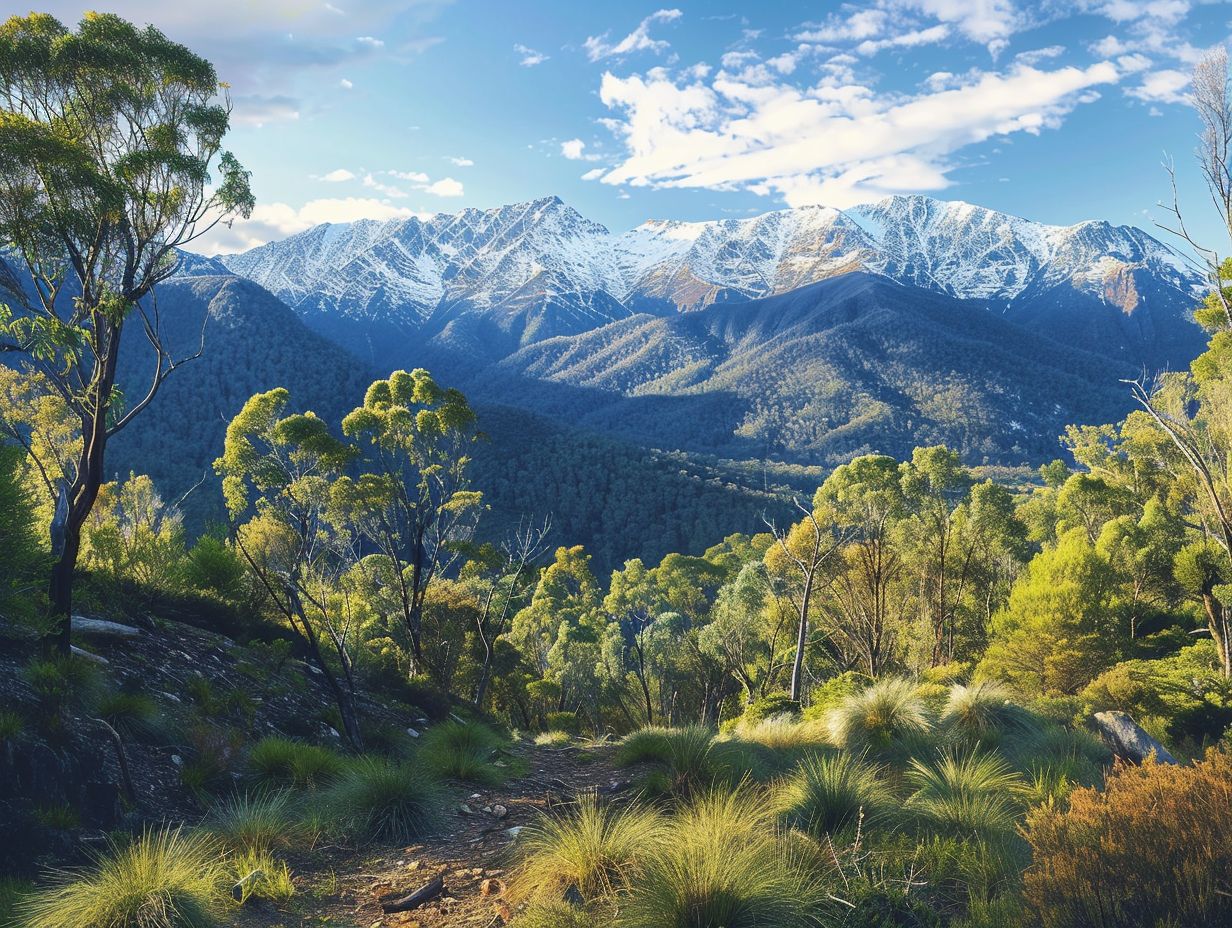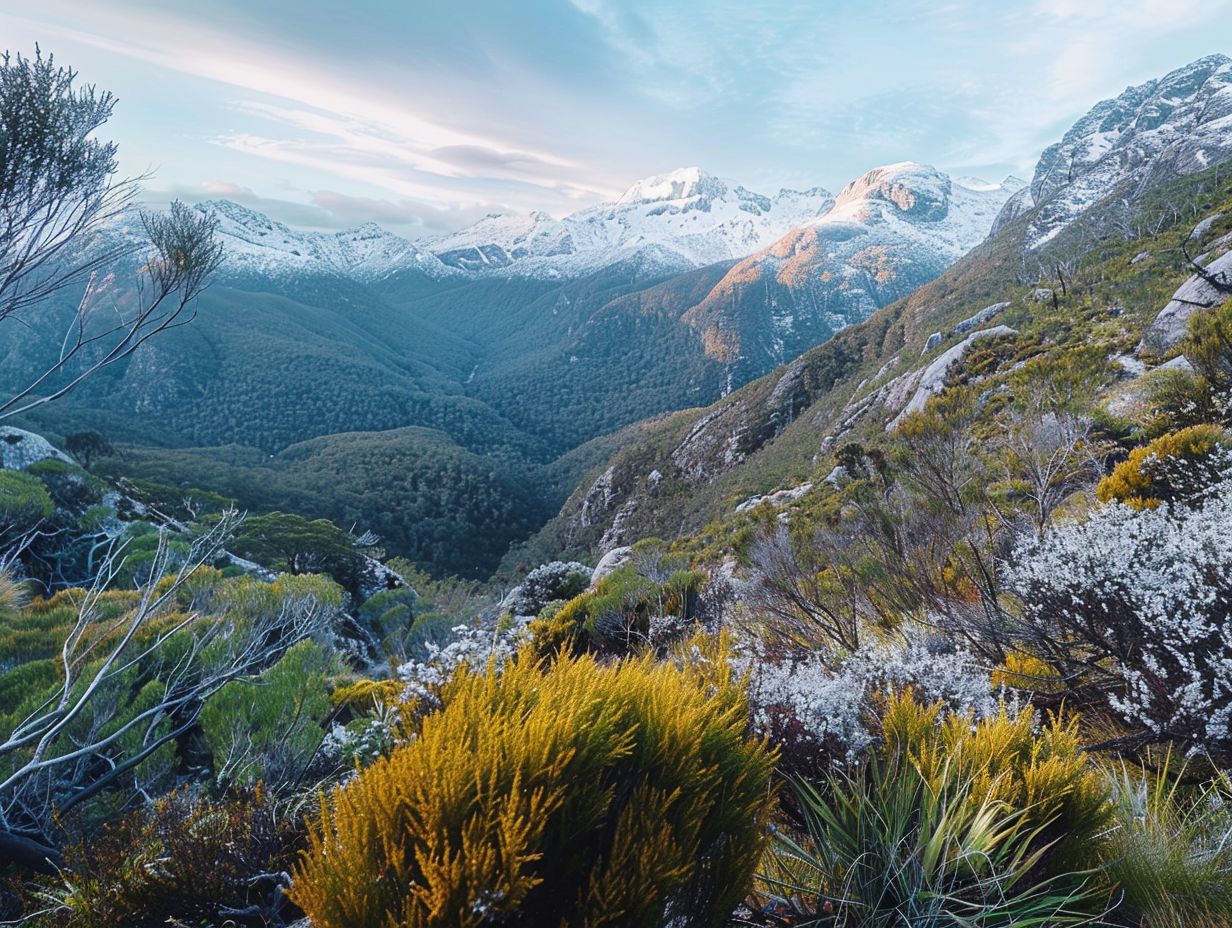
Tallest Mountains In Australia
Australia is home to some impressive mountain ranges, with Mount Kosciuszko standing tall as the highest peak in the country.
From Mount Townsend to Mount Lee, these majestic peaks offer not only breathtaking views but also a range of outdoor activities for adventure enthusiasts.
Explore the characteristics of these mountains, their location, and the exciting activities you can enjoy in these stunning natural wonders.
Key Takeaways:

- The tallest mountains in Australia are located in New South Wales.
- Mount Kosciuszko, Mount Townsend, Mount Twynam, Rams Head, and Mount Lee are the five tallest mountains in Australia.
- These mountains offer a variety of activities such as hiking, skiing, wildlife viewing, and camping.
What Are the Tallest Mountains in Australia?
Australia boasts several towering peaks, with Mount Kosciuszko, Mount Townsend, Mount Twynam, Rams Head, and Mount Lee standing out as the tallest mountains in the country.
1. Mount Kosciuszko
Mount Kosciuszko, located in the Snowy Mountains of New South Wales, stands as Australia’s highest peak, attracting visitors with its breathtaking summit views.
Nestled within the Kosciuszko National Park, this iconic mountain holds a significant place in the hearts of the local Aboriginal people, who refer to it as Tar-gan-gil.
The summit reaches a height of 2,228 meters above sea level, offering panoramic vistas of the surrounding alpine landscape.
Despite its awe-inspiring elevation, Mount Kosciuszko is accessible to hikers and adventurers of varying skill levels, thanks to well-maintained trails and guided tours.
The geological features of the mountain, shaped by ancient glacial activity, add to its allure, with unique rock formations dotting its slopes.
2. Mount Townsend
As one of the notable peaks in Australia, Mount Townsend in New South Wales offers a unique geological landscape and challenging climbing opportunities .
The geological composition of Mount Townsend showcases it’s ancient origins, primarily consisting of granite and metamorphic rocks that have been shaped by millennia of geological processes.
Climbers embarking on the ascent of this majestic peak are treated to breathtaking views of the surrounding Snowy Mountains and the lush alpine meadows below.
Mount Townsend’s climbing experiences range from moderate to difficult, with various routes catering to different skill levels.
The summit rewards climbers with a panoramic vista that includes the iconic Mount Kosciuszko, Australia’s highest peak.
The environmental features of Mount Townsend are home to a diverse range of flora and fauna, including rare alpine plants and animals.
Exploring this wilderness allows adventurers to immerse themselves in the beauty and serenity of Australia’s rugged landscapes.
3. Mount Twynam
Nestled in the picturesque Snowy Mountains region of Australia, Mount Twynam offers hikers and climbers a chance to explore it’s serene summit
Its breathtaking landscapes, characterized by vast alpine meadows and crystal-clear streams, create a haven for various species of birds, mammals, and flora.
Mount Twynam presents a challenging yet rewarding hiking experience, attracting outdoor enthusiasts seeking to immerse themselves in nature’s splendor.
The summit provides panoramic views of the surrounding peaks and valleys, offering a glimpse into the unique geological formations that shape the region.
With it’s rich biodiversity, including endemic plant species and elusive wildlife such as wallabies and echidnas, Mount Twynam serves as a vital ecological hotspot.
4. Rams Head
Rising majestically in the Snowy Mountains of Australia, Rams Head captivates visitors with its rugged terrain and varying climate conditions.
The mountain’s rugged landscape offers a diverse range of outdoor activities, from challenging hiking trails to exhilarating rock climbing opportunities.
It’s altitude ensures a wide range of climatic variations, providing visitors with a unique experience throughout the year.
In winter, Rams Head transforms into a winter wonderland, attracting skiing and snowboarding enthusiasts.
During the summer months, the mountain offers a cool retreat for hikers seeking refuge from the heat of the lowlands.
It’s rocky outcrops and lush vegetation provide a picturesque backdrop for nature lovers and photographers alike.
5. Mount Lee
Mount Lee, nestled amidst the stunning Snowy Mountains of Australia, offers a unique landscape rich in diverse flora and opportunities for exploration.
The mountain boasts a plethora of endemic plant species, including the vibrant Snow Gums, Alpine Ash, and the delicate Alpine Buttercups.
As hikers ascend the well-marked trails, they are greeted by the mesmerizing sight of wildflowers blooming in profusion, adding a touch of whimsy to the rugged terrain.
The extensive network of paths invites adventurers to delve deeper into the forested realms, witnessing the elusive Bogong Moths and the majestic Wedge-tailed Eagles.
Where Are These Mountains Located?

These impressive mountains are located in the captivating landscapes of New South Wales and Victoria, specifically within the renowned Snowy Mountains region in Australia.
The Snowy Mountains region boasts a stunning array of peaks, with the highest being Mount Kosciuszko, standing tall at 2,228 meters.
The area is also home to other notable peaks like Mount Jagungal and Mount Townsend. The picturesque landscapes of the Snowy Mountains are a haven for outdoor enthusiasts.
The region’s diverse flora and fauna, including unique alpine plants and wildlife, add to its charm and ecological significance.
1. Mount Kosciuszko – New South Wales
Mount Kosciuszko proudly resides in New South Wales, offering adventurers a chance to summit the highest point in Australia within its captivating National Park surroundings.
Despite being titled the highest peak in Australia, Mount Kosciuszko itself is a relatively modest summit, standing at 2,228 meters above sea level.
What it lacks in height, it makes up for in breathtaking views of the surrounding Snowy Mountains and the vast alpine meadows that stretch out before you.
As you ascend towards the summit, you’ll be treated to a variety of flora and fauna unique to this alpine region, with colorful wildflowers in spring and summer.
2. Mount Townsend – New South Wales
Mount Townsend stands tall in the picturesque landscapes of New South Wales, beckoning climbers with its challenging elevation and stunning views.
At an impressive height of 2,209 meters above sea level, Mount Townsend offers climbers a rewarding yet demanding ascent.
With it’s rugged terrain and varying rock faces, this peak attracts both amateur and experienced climbers looking to test their skills.
The climb to the summit presents diverse challenges, from steep ascents to rocky outcrops, providing a thrilling adventure for those seeking an adrenaline rush.
From the top of Mount Townsend, panoramic views unfold, showcasing the vast expanse of the Snowy Mountains and beyond.
On a clear day, climbers are treated to a breathtaking vista that extends as far as the eye can see, making the arduous journey to the peak truly worthwhile.
3. Mount Twynam – New South Wales
Discover the natural wonders of Mount Twynam in New South Wales, where wildlife thrives in its diverse habitat, offering visitors a glimpse into the unique ecosystem.
Home to a rich array of flora and fauna, Mount Twynam is a haven for numerous species, from the elusive mountain pygmy possum to the majestic wedge-tailed eagle.
The conservation efforts in this area have played a vital role in preserving the delicate balance of nature, ensuring that these animals have a safe sanctuary to thrive.
The habitat preservation initiatives on Mount Twynam are crucial for maintaining the biodiversity of the region, making it a significant ecological hotspot.
4. Rams Head – New South Wales
Explore the rugged beauty of Rams Head in New South Wales, where the terrain and climate create a unique environment for outdoor enthusiasts.
Rams Head, nestled in the heart of New South Wales, boasts a terrain characterized by soaring peaks, vast valleys, and dense alpine forests.
The rugged landscape offers a diverse range of activities such as hiking, mountain biking, and skiing, attracting thrill-seekers from far and wide.
The climate at Rams Head is known for its crisp mountain air and temperate summers, making it an ideal destination for year-round exploration.
Whether you’re scaling rocky cliffs or admiring tranquil alpine meadows, Rams Head provides a picturesque backdrop for outdoor adventures.
5. Mount Lee – New South Wales
Embark on an exploration of Mount Lee in New South Wales, where lush vegetation and scenic trails await, providing nature lovers with a tranquil retreat.
The myriad shades of green that blanket the slopes of Mount Lee create a mesmerizing sight, with towering eucalyptus trees swaying gently in the mountain breeze.
As you traverse the winding paths, you’ll encounter vibrant wildflowers in a riot of colors, adding an extra layer of beauty to the landscape.
The chirping of native birds fills the air, enhancing the peaceful ambiance of this natural sanctuary.
Whether you’re an avid hiker or simply seeking a quiet spot to unwind, Mount Lee offers a haven for all who appreciate the wonders of the great outdoors.
What Are the Characteristics of These Mountains?
These mountains exhibit diverse characteristics, from their geological formations and climatic conditions to the rich variety of flora and fauna.
1. Elevation

The elevation of these majestic mountains sets them apart, with towering peaks reaching impressive heights that offer panoramic views of the surrounding landscapes and beyond.
For example, Mount Everest, the highest peak in the world, rises to a staggering 29,032 feet above sea level.
The breathtaking sight from its summit reveals a vast expanse of jagged peaks and deep valleys below.
Similarly, the Rocky Mountains in North America boast elevations reaching over 14,000 feet, providing stunning vistas of lush forests and alpine meadows.
The Alps in Europe, with their peak heights exceeding 15,000 feet, showcase snow-capped summits glistening in the sunlight, creating a picturesque backdrop.
2. Geology
The geological composition of these mountains reveals a fascinating history of tectonic movements, volcanic activity, and rock formations that have shaped the rugged terrain and unique landscapes we see today.
Through millions of years of geological processes with layers of sedimentary rocks being uplifted and folded, creating dramatic peaks and valleys.
Mineralogical analysis of the rocks present in these mountains showcases a diverse range of minerals, from quartz and feldspar to mica and amphibole.
The igneous rocks, formed from molten magma deep within the Earth’s crust, have left their mark in the form of granite intrusions and volcanic cones.
3. Climate
The climatic conditions in these mountainous regions vary from snow-covered peaks in winter to vibrant landscapes in spring, creating diverse environments that support a wide range of flora and fauna.
During the winter months, these mountains experience heavy snowfall, transforming the peaks into a mesmerizing white wonderland.
The cold temperatures create a serene atmosphere, perfect for winter sports enthusiasts seeking thrilling adventures.
As spring approaches, the snow begins to melt, revealing lush greenery and blooming flowers that blanket the slopes.
The transition from winter to spring breathes new life into the ecosystems, with migratory birds returning and animals emerging from hibernation.
Summer brings warmer temperatures, allowing the flora and fauna to thrive under the sun’s nourishing rays.
The clear skies and mild weather attract hikers and nature lovers, offering stunning panoramic views of the surrounding landscapes.
Autumn paints the mountains with rich earthy tones as the leaves change color, creating a picturesque scene.
The cooler air signals the transition to winter, completing the remarkable cycle of seasonal changes in these majestic mountain ranges.
4. Flora and Fauna
The mountains host a rich diversity of flora and fauna, with unique plant species and wildlife thriving in these elevated environments.
Among the towering peaks and sprawling valleys, you can find a myriad of plant life, from hardy alpine flowers like Edelweiss to towering conifers such as the Douglas fir.
These diverse vegetation zones provide homes and food sources for a range of animals, including mountain goats, bears, and elusive snow leopards.
The mountains not only serve as a sanctuary for these creatures but also play a crucial role in preserving biodiversity and supporting fragile ecosystems.
What Are the Activities You Can Do in These Mountains?
These mountains offer a plethora of activities for outdoor enthusiasts, including hiking and trekking, skiing and snowboarding, wildlife viewing, camping, and backpacking.
1. Hiking and Trekking
Embark on thrilling hiking and trekking expeditions in these mountains, where scenic trails, panoramic views, and immersive wilderness experiences await adventurers.
Among the myriad options for avid hikers and nature enthusiasts, the mountainous terrain offers a diverse array of trails catering to all experience levels.
From gentle slopes ideal for beginners to challenging treks that test seasoned adventurers, there is something for everyone in these rugged landscapes.
Traverse through enchanting forests, cross crystal-clear streams, and ascend to majestic peaks that offer breathtaking vistas of sprawling valleys .
The spirit of exploration permeates the air, igniting a sense of wanderlust in all who dare to tread these ancient paths.
2. Skiing and Snowboarding
Embrace the snowy landscapes of these mountains by engaging in thrilling skiing and snowboarding activities, beckoning snow sports enthusiasts.
These majestic peaks offer a playground for both novice and seasoned skiers and snowboarders alike.
Carve your way down meticulously groomed slopes, surrounded by breathtaking panoramic views of snow-covered valleys and pine forests.
Feel the rush of adrenaline as you take on challenging runs or enjoy a leisurely glide through powdery snow.
The crisp mountain air and the sound of your skis swishing through the snow create an immersive winter sports experience that is unmatched.
3. Wildlife Viewing

Delight in the diverse wildlife of these mountains through captivating wildlife viewing experiences, where you encounter native fauna and conservation.
The Australian alpine regions are home to a multitude of fascinating creatures, from the iconic kangaroos and wallabies to the elusive echidnas and wombats.
Interacting with these creatures in their natural habitat provides a profound insight into the delicate balance of ecosystems.
Conservation initiatives play a vital role in preserving the rich biodiversity of the region.
Collaborative efforts between governmental bodies, conservation organizations, and local communities led to the establishment of protected areas.
4. 6Camping and Backpacking
Immerse yourself in nature by camping and backpacking in the mountains, where wilderness adventures, starlit skies, and remote trails promise a soul-refreshing escape.
Picture waking up to the crisp, fresh mountain air, surrounded by towering trees and the sounds of nature awakening.
As you sip your morning coffee by the campfire, you can plan your day of exploration along the scenic trails that wind through the rugged terrain.
Each step offers a new vista, from cascading waterfalls to panoramic mountain views.
The thrill of setting up camp in a secluded spot, pitching your tent under a canopy of stars, adds a touch of magic to the adventure.
Frequently Asked Questions
1. What is the tallest mountain in Australia?
A: The tallest mountain in Australia is Mount Kosciuszko, standing at 7,310 feet (2,228 meters) tall.
2. Where is Mount Kosciuszko located?
A: Mount Kosciuszko is located in the Great Dividing Range in the Snowy Mountains of New South Wales, Australia.
3. How many other mountains in Australia are taller than 6,000 feet?
A: Apart from Mount Kosciuszko, there are seven other mountains in Australia that are taller than 6,000 feet.
4. What is the second tallest mountain in Australia?
A: The second tallest mountain in Australia is Mount Townsend, standing at 7,238 feet (2,206 meters) tall.
5. How long does it take to hike to the summit of Mount Kosciuszko?
A: It takes about four to six hours to hike to the summit of Mount Kosciuszko, depending on your pace and fitness level.
6. Are there any guided tours available for hiking Mount Kosciuszko?
A: Yes, there are several guided tours available for hiking Mount Kosciuszko, ranging from day trips to multi-day expeditions.